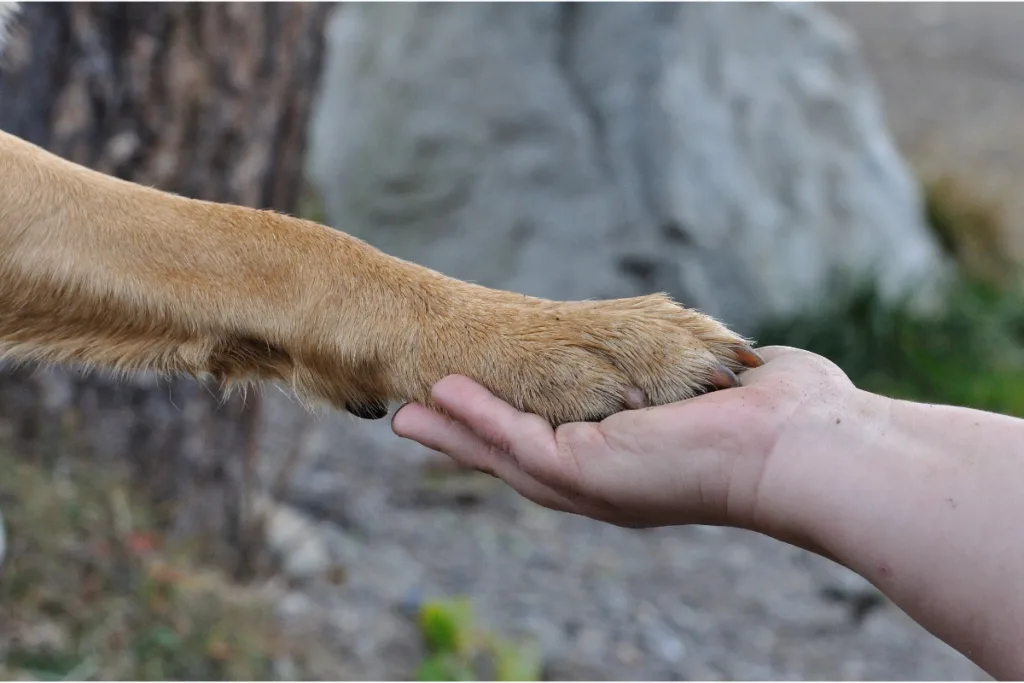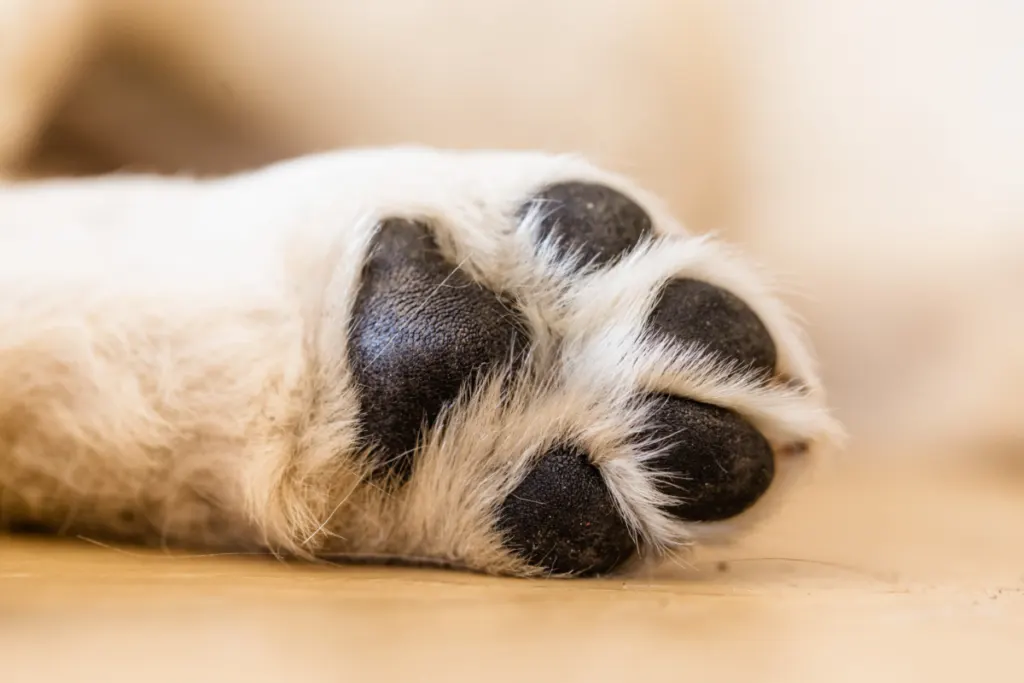Welcome to our comprehensive guide on dog paw health!
As a responsible pet owner, it’s crucial to prioritize the well-being of your furry friend, and that includes their paws.
Whether your dog enjoys leisurely walks or is an active athlete, maintaining healthy dog paws is essential for their overall happiness and mobility. In this article, we will explore the anatomy of dog paws and provide valuable tips on how to keep them in optimal condition.

Click Here to Jump to a Section
Key Takeaways:
- Understanding the anatomy of dog paws is key to appreciating the importance of paw health.
- Regular grooming routines, proper trimming, and moisturizing are essential for maintaining healthy dog paws.
- Common paw problems can be prevented through proper care and timely interventions.
- Remedies for dog paw problems range from natural remedies to over-the-counter solutions.
- Different environments require specific measures to maintain healthy dog paws, such as protecting them from hot pavement or cold weather.
Understanding the Anatomy of Dog Paws
The anatomy of dog paws is a fascinating subject that plays a crucial role in a dog’s overall well-being and mobility.
By understanding the intricate structure of dog paws, including the different parts such as the paw pads, nails, and toes, pet owners can develop a deeper appreciation for the significance of paw health.
A dog’s paw pads are perhaps the most recognizable feature of the paw anatomy.
These thick, cushioned pads provide protection and shock absorption while walking, running, or playing.
The paw pads also contain sweat glands that help regulate temperature and provide traction on various surfaces.
Nails, or clawed toes, serve multiple purposes in a dog’s life.
They assist in traction, digging, and gripping objects, making them essential for activities such as climbing or holding onto toys.
To further explore the anatomy of dog paws, we also need to consider the structure of the toes.
Dogs typically have four toes and a dewclaw, which is the fifth toe located higher up on the leg.
The toes contain muscles, tendons, and ligaments that allow for movement and stability.
By gaining a deeper understanding of the complex anatomy of dog paws, pet owners can better appreciate the importance of maintaining their pets’ paw health.
The next section will provide practical advice on how to keep your dog’s paws healthy, ensuring they lead a happy and active life.
Dog Paw Care: Tips for Keeping Them Healthy
Proper dog paw care is essential for maintaining your furry friend’s overall health and well-being.
By following a few simple tips and strategies, you can keep your dog’s paws healthy and happy.
Here are some practical ways to ensure optimal paw care:
Grooming Routine
Regular grooming plays a crucial role in paw health.
Start by routinely inspecting your dog’s paws for any signs of cuts, cracks, or foreign objects.
Thoroughly clean their paws with warm water and a mild dog-friendly soap to remove dirt and bacteria.
Finally, dry their paws thoroughly to avoid moisture-related issues.
Proper Paw Trimming
Trimming your dog’s nails is an essential part of paw care.
Overgrown nails can cause discomfort and lead to various problems such as infections or ingrown nails.
Use a proper dog nail trimmer and trim the nails to an appropriate length without cutting into the quick.
If you’re uncertain about nail trimming, consult a professional groomer or veterinarian.
Moisturizing
Keeping your dog’s paw pads moisturized can prevent dryness and cracking.
Use a dog-specific moisturizing balm or petroleum jelly to nourish their paw pads.
Apply a thin layer and massage it into the pads to provide hydration and protect against harsh weather conditions.

Paw Protection
If your dog frequently walks on hot pavement, rough terrain, or snowy surfaces, consider using protective dog booties.
These booties not only provide insulation and cushioning but also protect against harmful substances or extreme temperatures.
Remember to choose booties that fit your dog comfortably and allow them to move naturally.
Regular Paw Inspections
Make it a habit to inspect your dog’s paws regularly.
Look for any signs of redness, swelling, or unusual growths.
If you notice anything out of the ordinary, consult your veterinarian for a proper diagnosis and treatment.
By implementing these tips for dog paw care, you can ensure your furry friend’s paws remain healthy, comfortable, and ready for all their adventures!
Common Paw Problems in Dogs and Prevention
When it comes to our furry friends, their paws play a crucial role in their overall well-being.
Unfortunately, dogs are prone to a variety of paw problems that can cause discomfort and affect their quality of life.
In this section, we will discuss some of the most common paw issues that dogs face and provide valuable prevention techniques to keep your canine companion’s paws healthy and happy.
Cuts and Abrasions
One of the most prevalent paw problems in dogs is cuts and abrasions.
These can occur due to sharp objects, rough terrains, or even from excessive scratching.
To prevent these issues, it’s important to regularly inspect your dog’s paws for any signs of cuts or injuries.
Keep their nails trimmed to avoid accidental scratches, and if your dog is frequently exposed to rough surfaces, consider using protective boots to minimize the risk of cuts and abrasions.
Infections
Dog paws are susceptible to infections, which can be caused by bacteria, yeast, or even foreign objects that get lodged between the paw pads.
Signs of an infected paw may include redness, swelling, discharge, or limping.
To prevent infections, practice good hygiene by regularly cleaning your dog’s paws after walks or outdoor activities.
Additionally, avoid walking them in areas with known contamination, such as stagnant water or dirty environments.
Dry and Cracked Paw Pads
Dry and cracked paw pads are another common issue that can lead to discomfort for your dog.
Environmental factors like hot pavement, cold weather, or excessive exposure to rough surfaces can cause the paw pads to dry out and crack.
To prevent this, make sure your dog’s paws are adequately moisturized.
You can use specialized paw balms or even natural alternatives like coconut oil to keep the paw pads hydrated and supple.
Remember, prevention is key when it comes to common paw problems in dogs.
By taking proactive steps to protect and care for your pet’s paws, you can help minimize the risk of these issues and keep your furry friend happy and active.
Remedies for Dog Paw Problems
Dog paw problems can be quite common and can cause discomfort to your furry friend.
Thankfully, there are various remedies and treatments available to alleviate these issues and promote paw pad care.
When it comes to natural remedies, one effective option is to create a soothing paw soak using warm water and Epsom salt.
This can help soothe inflammation and relieve pain in your dog’s paws.
Additionally, consider applying a natural moisturizer such as coconut oil or shea butter to keep the paw pads hydrated and prevent dryness and cracking.
In some cases, over-the-counter solutions may be necessary.
Paw balm or ointments specifically formulated for dog paws can provide protection and aid in the healing process.
Be sure to follow the product instructions and consult with your veterinarian if you have any concerns.
However, it’s important to note that not all paw problems can be treated at home.
If your dog’s paw issue persists or worsens despite your efforts, it’s crucial to seek veterinary care.
A vet can provide a proper diagnosis and recommend the appropriate treatment plan, which may include medications or specialized therapies.
Remember, keeping a close eye on your dog’s paws and addressing any problems promptly is key to maintaining their overall paw health.
By utilizing the right remedies and seeking professional advice when needed, you can help your furry companion stay comfortable and happy on their paws.

Maintaining Healthy Dog Paws in Different Environments
Dogs are no strangers to different environments, and each one presents unique challenges to maintaining healthy paw pads.
Whether you and your furry companion are strolling on hot pavement, braving the cold weather, or adventuring on rough terrains, it’s crucial to prioritize paw care to ensure your dog’s well-being.
In hot weather, asphalt and other surfaces can become scorching and cause burns or blisters on your dog’s paw pads.
To protect their paws, try to walk them early in the morning or late in the evening when the temperature is cooler.
You can also invest in booties specifically designed for hot surfaces.
These booties provide an extra layer of insulation and prevent burns.
Cold weather can be harsh on dog paws, especially when exposed to icy sidewalks and freezing temperatures.
Before heading outside, apply a paw protectant, such as a balm or petroleum jelly, to create a barrier against the elements.
Additionally, consider putting booties on your dog’s paws to shield them from icy surfaces and harsh chemicals often used to melt snow and ice.
Rough terrains, such as rocky trails or sandy beaches, can pose a risk of cuts and abrasions to your dog’s paw pads.
Inspect your dog’s paws regularly for any signs of injury, like bleeding or limping.
Investing in sturdy dog shoes or boots can offer excellent protection, especially during longer hikes or beach adventures.
Remember, maintaining healthy dog paws is crucial to their overall comfort and mobility.
By being mindful of different environmental challenges and taking appropriate preventive measures, you can ensure your canine companion enjoys happy and active paws throughout their life.
Paw Care for Active Dogs
Active dogs, such as those involved in sports or outdoor activities, require special attention to their paws.
Engaging in rigorous physical activities can put stress on the paws, making it crucial to prioritize their care and protection.
One key aspect of paw care for active dogs is proper paw protection.
Depending on the activity, you may need to invest in protective gear such as booties or paw balms.
These can shield your dog’s paws from potential injuries, hot surfaces, or rough terrain.
Remember to choose products specifically designed for dogs, as human products can contain ingredients that may be harmful to them.
Additionally, regular post-activity care is essential to maintain paw health.
After each workout or outdoor adventure, thoroughly inspect your dog’s paws for any signs of cuts, splinters, or foreign objects.
Gently clean their paws with a damp cloth or pet-friendly wipes to remove dirt and debris.
Pay particular attention to the paw pads and the space between their toes as these areas are prone to accumulating debris.
Incorporating regular paw moisturization can also help keep their paws in top condition.
Look for paw balms or moisturizers enriched with natural ingredients such as shea butter or coconut oil.
Apply a thin layer onto their paw pads to keep them hydrated and minimize the risk of dryness or cracking.
Remember to consult with your veterinarian for specific guidance on paw care routines and product recommendations based on your dog’s individual needs.
By prioritizing paw care for your active pup, you can help prevent discomfort, injuries, and potential complications.
Final Thoughts
In conclusion, maintaining the health of your dog’s paws is crucial for their overall well-being.
By understanding the anatomy of their paws and implementing proper care routines, you can ensure that they have happy and healthy feet throughout their life.
Taking the time to regularly inspect and groom your dog’s paws, including trimming their nails and moisturizing their paw pads, can help prevent common paw problems.
Additionally, being aware of the different environments your dog may encounter, such as hot pavement or rough terrains, will enable you to take appropriate measures to protect their paws.
If you notice any signs of discomfort or issues with your dog’s paws, it’s important to address them promptly.
Consulting with a veterinarian and utilizing specific remedies or treatments can help alleviate any problems and promote healing.
Remember, caring for your dog’s paws is not just about their physical health, but also their overall happiness.
Prioritizing their paw health will ensure that they can continue to enjoy their daily activities and adventures with comfort and ease.
